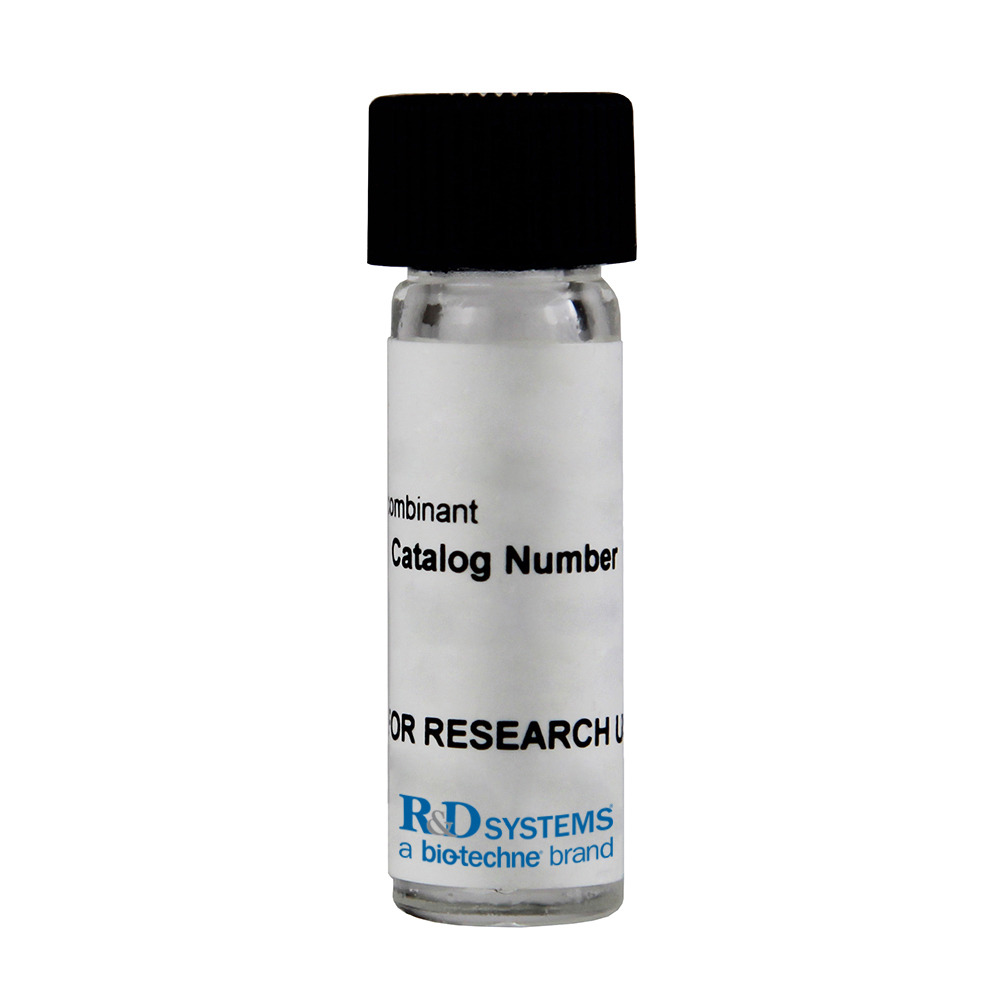Recombinant Mouse MAG/Siglec-4a Fc Chimera Protein, CF
Recombinant Mouse MAG/Siglec-4a Fc Chimera Protein, CF Summary
Product Specifications
| Mouse MAG/Siglec-4a (Gly20-Pro516) Accession # P20917 |
IEGRMDP | Mouse IgG2a (Glu98-Lys330) |
| N-terminus | C-terminus | |
Analysis
Product Datasheets
8580-MG
Carrier Free
CF stands for Carrier Free (CF). We typically add Bovine Serum Albumin (BSA) as a carrier protein to our recombinant proteins. Adding a carrier protein enhances protein stability, increases shelf-life, and allows the recombinant protein to be stored at a more dilute concentration. The carrier free version does not contain BSA.
In general, we advise purchasing the recombinant protein with BSA for use in cell or tissue culture, or as an ELISA standard. In contrast, the carrier free protein is recommended for applications, in which the presence of BSA could interfere.
8580-MG
| Formulation | Lyophilized from a 0.2 μm filtered solution in PBS. |
| Reconstitution | Reconstitute at 200 μg/mL in PBS. |
| Shipping | The product is shipped at ambient temperature. Upon receipt, store it immediately at the temperature recommended below. |
| Stability & Storage: | Use a manual defrost freezer and avoid repeated freeze-thaw cycles.
|
Background: MAG/Siglec-4a
Myelin-Associated Glycoprotein (MAG), also known as Siglec-4a, is a type I transmembrane glycoprotein belonging to the Siglec family, a subgroup of the Ig superfamily (1). It is composed of an extracellular segment containing five Ig-like domains, a single transmembrane segment, and a cytoplasmic domain. Mature mouse MAG exists as two isoforms, termed S-MAG (short) and L-MAG (long), due to alternative splicing of the cytoplasmic domain (1, 2). S-MAG has a predicted molecular weight of 67 kDa while L-MAG has a predicted molecular weight of 71 kDa (1, 2). Additionally, proteolytic cleavage of the extracellular domain produces a soluble MAG (3). Within shared regions in the extracellular domain, mouse MAG shares 95% and 99% aa sequence identity with human and rat MAG, respectively.
MAG functions as an adhesion molecule during neural development. It preferentially binds to alpha -2,3-linked sialic acid terminal structures found on cell surface molecules (1, 4, 5). MAG is selectively expressed by myelinating oligodendrocytes and Schwann cells and plays an important role in axon-myelin stability (1, 4). Specifically, L-MAG is involved in myelination in the central nervous system (CNS) while S-MAG is the predominant isoform expressed during myelination in the peripheral nervous system (1). MAG is also reported to regulate the axon cytoskeleton and support the distribution of axon molecules at the nodes of Ranvier (1, 4). In addition, it has been identified as a major inhibitor of neurite outgrowth (1, 4, 6). However, MAG has also been reported to protect neurons from excitotoxicity (1, 7). MAG is believed to utilize the gangliosides GD1a and GT1b, the Nogo receptors NgR1 and NgR2/NgRH1, Integrin beta 1/CD29, and PIR-B to mediate its effects (1, 4, 5, 8, 9). Soluble MAG, which is released from myelin in large quantities, has been identified in normal human tissues and in tissues from patients with neurological disorders (3). It is believed that this soluble MAG might contribute to the lack of CNS neuron regeneration after injury (3).
- Lopez, P.H. (2014) Adv. Neurobiol. 9:245.
- Salzer, J.L. et al. (1987) J. Cell Biol. 104:957.
- Tang, S. et al. (1997) Mol. Cell. Neurosci. 9:333.
- Schnaar, R.L. and P.H. Lopez (2009) J. Neurosci. Res. 87:3267.
- Schnaar, R.L. (2010) FEBS Lett. 584:1741.
- Akbik, F. et al. (2012) Exp. Neurol. 235:43.
- Lopez, P.H. et al. (2011) J. Neurochem. 116:900.
- Atwal, J.K. et al. (2008) Science 322:967.
- Goh, E.L. et al. (2008) Mol. Brain 1:10.
FAQs
No product specific FAQs exist for this product, however you may
View all Proteins and Enzyme FAQsReviews for Recombinant Mouse MAG/Siglec-4a Fc Chimera Protein, CF
There are currently no reviews for this product. Be the first to review Recombinant Mouse MAG/Siglec-4a Fc Chimera Protein, CF and earn rewards!
Have you used Recombinant Mouse MAG/Siglec-4a Fc Chimera Protein, CF?
Submit a review and receive an Amazon gift card.
$25/€18/£15/$25CAN/¥75 Yuan/¥2500 Yen for a review with an image
$10/€7/£6/$10 CAD/¥70 Yuan/¥1110 Yen for a review without an image

